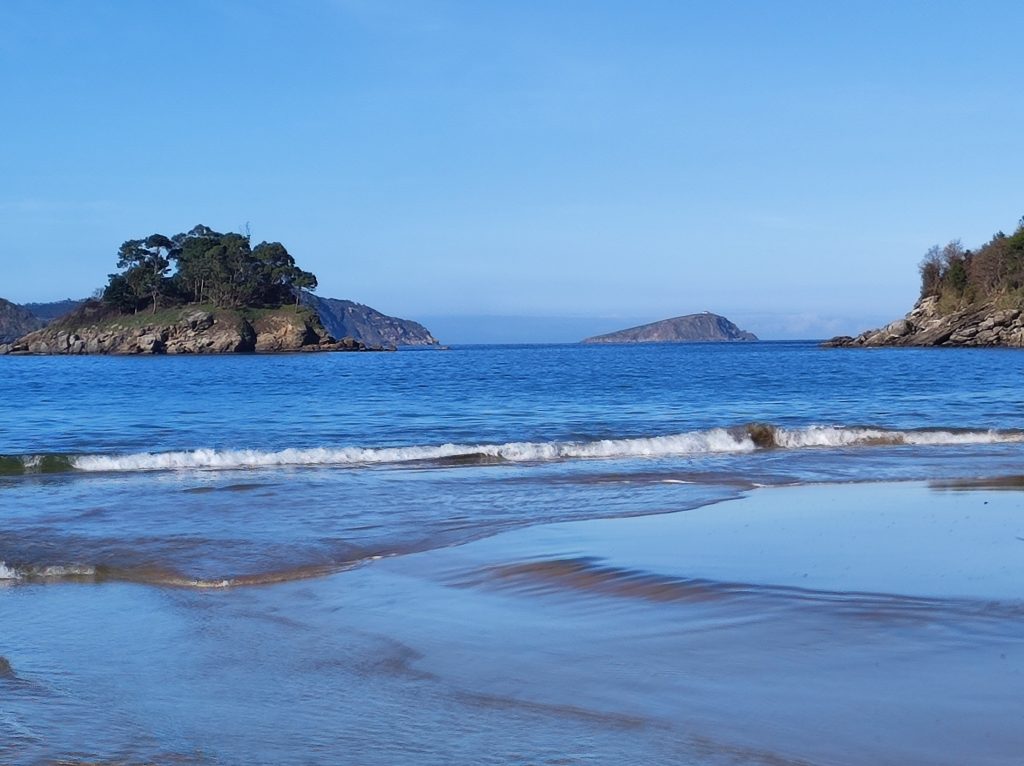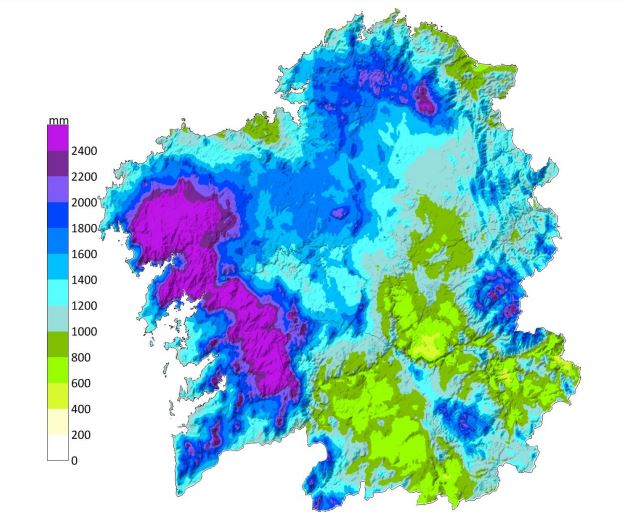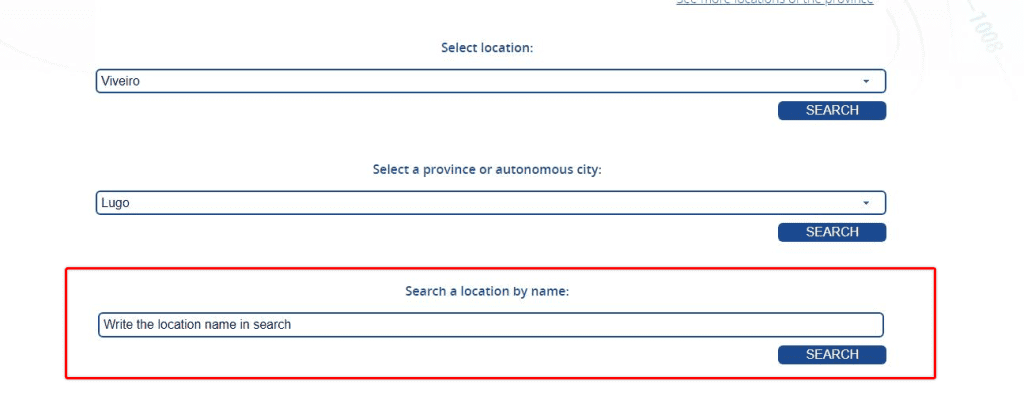What’s the weather like in Galicia? This is a question that people looking to visit this wonderful corner of the world are likely to be asking and in this blog post, I try to answer this question and let you know about the weather on the north Galicia coast and how you can research the weather when planning your trip.
To see the weather forecasts for the A Mariña coast check out our post HERE!
The coast of Lugo is one of the most beautiful and varied areas of Galicia, with landscapes ranging from white sand beaches and crystalline waters to cliffs and estuaries. The climate in this area is oceanic, which means that it has mild winters and cool summers, with an average annual temperature of about 14°C. The rain is abundant throughout the year, but especially in autumn and winter, when the famous Atlantic storms occur. On average, the Lugo coast experiences around 80 rainy days per year*, with the wettest months typically being November, December, and January.

Is Galicia Rainy?
People thinking of visiting the North coast of Galicia will often ask ‘is Galicia rainy’? And the answer is yes – or no, largely depending on your perspective. If you are visiting from a North European country with a high rainfall, Galicia will have less rain than you are used to, on the other hand, when comparing it with the South of Spain or other southern European countries and the weather will be markedly different. It’s this rainfall that creates the lush green environment and the abundance of inland springs and natural streams and rivers which are a delight to explore.

One thing to be aware of is that Galicia is a large province with a diverse landscape and the weather varies by location. In the map above, you will see that the Lugo coast, a Mariña is in the green band, with 600/800 mm of rainfall a year, while in the mountainous regions in the west, three times this rainfall is experienced. So it is very difficult to make a broad pronouncement about the rain and weather of Galicia, you really need to hone in on where you plan to visit.
The Weather On the Lugo Coast
The weather on the Lugo coast of Galicia is temperate, which means it does not experience the extreme highs and lows of other areas of Spain. This means we don’t have freezing temperatures in the winter nor the high dry arid temperatures in the height of summer. However, the weather is also more unpredictable and varied.
Here’s a great example – this is the weather on 22nd March over the last 5 years in Viveiro, Lugo. You will see it has been different every year!

This shows how difficult it is to predict the weather when you are planning a trip.
How to Check the Weather Before and During Your Trip
If you want to check the weather forecasts as part of your research before visiting or to check the weather when you are here, there are a few extremely useful apps and websites. The Twitter account of Twitter account of MeteoGalicia is worth following and you can check out the websites and apps below:
AEMET
One of the most complete and reliable web pages for the weather in Viveiro is that of the State Meteorological Agency (AEMET), which is the official body of the Spanish government in charge of preparing weather forecasts. On their website you can find detailed information about the current weather and forecasts for the next 7 days, both in table and graph form. You can also see the probability of rain, snow or storm, as well as alerts for wind or coastal phenomena. You can change the language on the AEMET website to English and you are looking for ‘predictions’. This link will take you to the Viveiro page, to find your own destination just type in the town name at the bottom of the page.

El Tiempo
Another very useful website for weather in Galicia is El Tiempo.es, which is a digital platform specialized in meteorology. On this website you can check the current weather and forecasts for the next 14 days, with information on temperature, wind chill, humidity, atmospheric pressure, wind speed and direction, and the UV index. You can also see interactive maps with satellite images and rain radars. This link will take you to the English version of the site, however it can be accessed in a variety of languages – El Tiempo.
World Weather Online
Another great source for weather data which is useful for research as well as weather predictions World Weather Online. Both ‘History’ and ‘Averages’ is useful for research.

AccuWeather App
If you prefer to use a mobile app for weather on the Lugo coast, I suggest you download AccuWeather, which is one of the most popular and accurate apps in the world. With AccuWeather you can access current weather and forecasts for the next 15 days, with data on actual and perceived temperature, hourly and daily rainfall, UV index and air quality. You can also receive personalized alerts for extreme conditions or sudden changes in the weather. AccuWeather is available for Android and iOS.
WeatherSpark
WeatherSpark is another great resource. This is particularly useful for comparisons. You can compare the weather in a couple of destinations for comparison of rainfall, temperatures, UV index, percentage chance of clear skies etc.
When to Visit North Galicia Coast
This very much depends on when you can visit and what you want to do. Late Spring and early Autumn are great options as the weather is still warm, the sea is warming up or still warm from summer yet there are less tourists. If you are a keen surfer, the Autumn and Winter are the best options. Easter is a wonderful time to visit if you want to do some hiking and take in some of the big Easter celebrations such as the Semana Santa parades in Viveiro.
How to Plan for Your Trip to Galicia’s North Coast
As we have seen, the biggest challenge when visiting is the weather is varied and the weather pattern is difficult to predict one year to the next. Therefore, when visiting the North Galicia coast, it’s best to plan for all eventualities (well, within reason, unless you head inland, you are unlikely to experience snow or ice!).
In addition to packing for the possibility of rain, there are some other things you can do to make the most of your trip to the Lugo coast. For example, consider scheduling outdoor activities for the times when the weather is likely to be drier, or plan indoor activities for rainy days. There are plenty of museums, galleries, and other indoor attractions in the region to keep you busy when the weather is less than ideal.
Overall, the Lugo coast is a beautiful and unique destination that offers plenty to see and do, rain or shine. While it may rain more than the Costas in the south of Spain, it doesn’t rain all day every day, and with some planning and flexibility, you can have an amazing trip, taking in wonderful beaches and awesome scenery. So don’t let the weather hold you back – embrace the rain and enjoy all that this beautiful region has to offer.
*In 2022 Viveiro had 82 rainy days, Ribadeo 74 rainy days and Lugo, the capital 84 rainy days (Source: world weather online)

